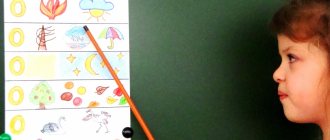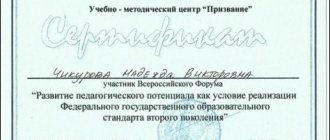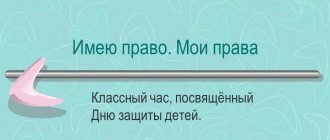Summary of the speech at the methodological association of the preschool educational institution
Anna Soboleva
Summary of the speech at the methodological association of the preschool educational institution
The inner world of a preschooler: correction of the pedagogical view.
Interaction with aggressive children
.
The development of a child’s aggressive behavior is influenced by many factors (somatic diseases, brain diseases, as well as various social factors - scenes of violence from TV screens contribute to an increase in the viewer’s level of aggressiveness (proven by researchers, parenting styles in the family). With an authoritarian style of education, where strict punished for any manifestation of aggressiveness, the child learns to hide his anger in the presence of his parents and does everything “on the sly.” The permissive attitude of adults towards the child’s aggressive outbursts also leads to the formation of aggressive personality traits in him. If an adult, in communicating with a child, is characterized by excessive compliance, uncertainty educational process, then children do not feel completely safe and also become aggressive.
It is advisable to work with aggressive children in four directions:
teaching aggressive children how to express anger in acceptable ways;
teaching children self-regulation techniques and the ability to control themselves in various situations;
practicing communication skills in possible conflict situations;
formation of such qualities as empathy, trust in people, etc.
Teaching aggressive children ways to express anger in acceptable ways.
We teach children to directly express their feelings. Passive-aggressive children do everything on purpose, but on the sly. Such children need to be taught to express and express their anger. The more anger is expressed in words, the less of it will remain.
We teach younger children to express anger indirectly, using game techniques (“Stubborn Pillow”, rubber balls in water, the game “Battle” with foam balls, a glass for screaming, a hammer, “Karateka”, “Boxer”, “Little cast"). All these objects and games are needed so that the child directs his anger not at people, but transfers it to inanimate objects, splashes it out in a playful form.
Teaching children self-regulation techniques.
Aggressive children are often characterized by muscle tension, especially in the face and hands. Therefore, any relaxation exercises will be useful for this category of children. For example, “Warm as the sun, light as a breath of wind” - children with their eyes closed imagine a warm, wonderful day. “Smile” helps to relax the facial muscles. — children, inhaling the air, smile repeatedly at the ray of the sun, they become a little kinder. In unpleasant life situations, they can remember their feelings worked out in these and other similar games, and return to them, replacing negative emotions with neutral or positive ones. (“Cat”, “Silver Hoof”)
Practicing communication skills.
Aggressive children sometimes show aggression only because they do not know other ways to express their feelings. The adult’s task is to teach them how to get out of conflict situations in acceptable ways. One of the techniques is role-playing. Acting out different situations in a group.
Sometimes, and quite often, children offer aggressive ways to get out of the current situation, for example: shout at each other, hit, take away a toy, intimidate. An adult should not criticize or evaluate the child’s proposal. On the contrary, it should offer children this option for role-play. During the discussion, they, as a rule, become convinced of the ineffectiveness of this approach to the problem. (Malvina, Pinocchio)
Formation of positive personality traits.
It is believed that it is possible to develop empathy and form other personality traits while reading together between an adult and a child. By discussing what has been read, the adult encourages the child to express his feelings. In addition, it is very useful to compose fairy tales and stories with your child. (game “My Good Parrot”, “Tender Name”, etc.).
Interaction with hyperactive children.
Most researchers note three main blocks of hyperactivity: attention deficit, impulsivity, and increased motor activity. This is a medical diagnosis and can only be made by a specialist.
Some children with ADHD have high compensatory abilities. But for them to turn on, certain conditions are needed. (favorable environment without intellectual overload with an appropriate regime, special program, drug treatment.
When working with GA children, three main areas are used:
1. Development of deficit functions (attention, behavioral control, motor control).
2. Practicing communication skills with adults and peers
3. If necessary, work with anger.
Development of deficit functions.
It should be carried out in stages, starting with the development of one function. It is difficult for a child to be attentive, calm, and not impulsive at the same time.
Games: “What’s new” (concentration of attention on details, games with sand and water, “listen to the silence” (development of attention and self-control, game “Speak!” (development of the ability to control impulsive actions, game “My triangular cap” (concentration attention, body awareness, movement control, behavior control)
When practicing communication skills with peers and adults
The same principles are used as when working with aggressive children.
It is necessary to communicate with a GA child gently and calmly. If the task is completed, then without shouting and orders, but also without enthusiastic intonations or an emotionally uplifted tone. He will take over the mood and emotions will prevent him from performing further successful actions.
For children to feel safe, they simply NEED clear boundaries of what is permitted and mandatory “feedback” from an adult.
We must remember that a child needs praise and approval from adults to strengthen his self-confidence. For successful completion of a task, for perseverance, for attentiveness, for accuracy, it is better to praise not too emotionally, so as not to overexcite the child.
Instructions for GA children should not be verbose and contain no more than 10 words. Assignments must be given sequentially and gradually. (Go to the group, put away the toys, then wash your hands and come sit on a chair).
Try not to use sharp prohibitions “No!”, “You can’t!” otherwise, due to impulsiveness, the child will immediately react with disobedience or verbal aggression. (Tip: if a child is rushing around the group, give a choice of two or three other activities: listen to reading, draw, assemble something from a construction set, etc.)
Sometimes children find it difficult to switch from one activity to another due to impulsiveness. Then it is better to warn about this a few minutes before the start of a new activity: “In 10 minutes we are collecting toys. Fine?". In order not to cause aggression, it is better if, after time has passed, he is reminded of this, for example, by a bell.
Interaction with anxious children.
Many studies allow us to conclude that some socio-psychological factors, such as parents’ dissatisfaction with their work, financial situation and living conditions, have a significant impact on the development of anxiety in children.
But most often, anxiety develops when the child is in a state (situation) of internal conflict. It can be called:
negative demands placed on the child, which can humiliate or put him in a dependent position;
inadequate, most often exaggerated demands;
conflicting demands that parents and the kindergarten place on the child.
We need to work in three directions:
1. Increase the child’s self-esteem.
2. Teaching children ways to relieve muscle and emotional tension.
3. Practicing self-control skills in situations that are traumatic for such children.
Increasing the child's self-esteem.
Very often, anxious children have low self-esteem, which is expressed in a painful perception of criticism from others.
To help your child improve their self-esteem, you can use the following:
It is necessary to call the child by name more often and praise him in the presence of other children and adults.
Celebrate the child’s achievements at the “Star of the Week”, “We Can Do It”, “I Did It!” stands.
encourage such children by entrusting them with carrying out tasks that are prestigious in the given team (distributing notebooks, bread, materials).
Compare only with yourself
avoid timed tasks, ask in the middle of the lesson, give time to think without repeating your question twice or three times - otherwise the child will not answer soon or will not answer at all, because he will perceive each repetition of the question as a new stimulus.
Establishing eye-to-eye contact will instill a sense of trust in the child’s soul.
Conduct conversations with a group of children, during which all children talk about the difficulties they experience in certain situations. Such conversations help the child to realize that their peers also have problems related to their own.
Games:
“Praises” - increasing self-esteem. (voice out on cards the actions approved by others “Once upon a time I.”
“Why my mother loves me” - increasing importance in the eyes of other children.
Teaching your child ways to relieve muscle and emotional tension.
Emotional tension in anxious children most often manifests itself in muscle tension in the face, neck, and abdomen.
Games and tension-relieving exercises help teach children ways to relieve muscle tension. For example, “Sculpture” - develops the ability to control the muscles of the face, arms, legs, and reduces muscle tension.
Exercise “Fight” - helps to relax the muscles of the lower face and hands.
Children's auto-training (Bottom of the sea, Flight of a butterfly, On a ship (first stand straight, then shake the deck and alternately strain and relax your legs, sunbathe.
In addition to relaxation games, you need to play games based on physical contact with the child (“Cake”, “Affectionate Chalk”, “musicians”).
Use elements of massage or simply rubbing (Tender chalk, late train.)
organize impromptu masquerades.
Practicing self-control skills in situations that traumatize a child.
Even if work is being done to increase self-esteem and ways to reduce muscle and emotional tension, there is no guarantee that the child, finding himself in a real-life or unforeseen situation, will behave adequately. Therefore, it is necessary to work out specific situations.
Role-playing game comes to the rescue again. By playing the role of weak and cowardly characters, the child becomes better aware and concretizes his fear. An adult needs to be helped to see fear from the other side. It’s good if it’s comical, then this fear won’t be so significant. By playing the role of strong heroes, the child gains a sense of confidence that, like his hero, he is capable of coping with difficulties.
At the same time, it is important not only to play with children, but also to discuss how to use this experience in life situations. In NLP this is “future tuning”.
It is advisable to choose difficult cases from the life of each child as subjects for role-playing games. Let me play different roles.
The most effective way to play with kids is to play with dolls. Children must choose the “brave” and “cowardly” doll themselves. The roles are distributed as follows: the child speaks for the “cowardly” doll, and the adult speaks for the “brave” doll. Then you need to switch roles. This allows children to look at the situation from different points of view, and having experienced the “unpleasant” plot again, get rid of the negative experiences that haunt them. Moreover, if a child experiences anxiety when communicating with an adult, you can compose a dialogue in which the adult’s doll will play the role of the child, and the child’s doll will be responsible for the adult.
It is also necessary to work with parents about feasible demands on the child, about overprotectiveness, “spreading straws,” how to deal with fears (don’t make fun of them, don’t persuade them so as not to be afraid, a lot of comments and shouts.
As a rule, parents of anxious children themselves are highly anxious, and therefore have low self-esteem, suffer from muscle tension, and are not satisfied with themselves and their actions. Such parents need to first engage in self-education, and a psychologist will help them with this.
Speech at a methodological association on the topic: “Implementation of the Federal State Educational Standard for Physical Education in remedial classes.”
Speech at a method association on the topic:
“Implementation of the Federal State Educational Standard for Physical Education in remedial classes.”
The main goal of the new Federal State Educational Standards was to reveal the child’s personality, his talents, the ability for self-learning and teamwork, the formation of responsibility for his actions, and the creation of a friendly environment, including during extracurricular hours.
The standard of general education for students with mental retardation ensures the formation of personality taking into account their special educational needs, based on the development of individual abilities, positive motivation and basic skills in educational activities (mastery of reading, writing, counting, etc.), as well as simple self-control skills, culture of behavior and speech, the basics of personal hygiene and a healthy lifestyle.
I started work by drawing up adapted work programs for academic subjects in accordance with the requirements of the new standard.
At a parent meeting, she spoke about the introduction of the Federal State Educational Standard for children with disabilities. Folders for student portfolios were immediately purchased, because... One of the tasks of teaching and raising children with disabilities is to identify and develop the child’s individual creative abilities. How can you capture these creative abilities? In my opinion, only by creating an individual “portfolio” of the student. There are currently no strict requirements (state standard) for creating a portfolio, and the options for general education classes are not entirely suitable for us. Therefore, I myself chose the sections that, in my opinion, are most justified for correctional classes.
The main function of the portfolio of students of a basic secondary school is the opportunity to present their achievements when entering universities. For a student with disabilities, this function is unacceptable, because our graduates will not enter universities. But for vocational schools it is not so important.
The main function of a student’s portfolio in correctional classes is to show the dynamics of development to parents. The portfolio becomes a “mirror” of learning and education throughout the entire course of schooling. Each parent expects positive dynamics in the development of their child from teachers, while often shifting the role of education and development to teachers. Therefore, it is up to the teacher to compile, design and update the portfolio. Unfortunately, there is a financial problem in registration.
What to put in the portfolio of a student with disabilities? Anything: photographs showing different types of activities in the classroom and in the after-school group; certificates, diplomas of participation in competitions, festivals; notebooks, copybooks, drawings, etc.
The new generation standard is based on a systemic-activity approach, the main result of which is the development of the child’s personality based on UUD.
The formation and development of universal educational actions is closely related to a sufficient level of psycho-physiological development of the child. Readiness to learn implies the formation of:
— knowledge and ideas about the world around us;
- mental operations, actions and skills;
- speech development, which presupposes mastery of a dictionary, grammatical structure of speech, coherent utterance, etc.;
— cognitive activity, manifested in interests and motivation;
- regulation of behavior.
In children with disabilities, all this is formed to varying degrees and, as a rule, with a deficiency. Therefore, correctional and developmental approaches and technologies in teaching come to the fore.
In my work, I make sure to use modern technologies that optimally ensure the results of the Federal State Educational Standard:
ICT;
design technology;
research technology;
health-saving and gaming technologies.
One of the important tasks in the lessons is the development of children's speech, because... Children with intellectual disabilities have a very poor vocabulary and multiple speech defects. During lessons, children work according to their capabilities and are sure to participate in dialogue. I try to adhere to the structure of the lesson according to the Federal State Educational Standard.
An educational class system has also been developed, the purpose of which is –
creating conditions for the education and socialization of a moral personality, ready for active, creative and initiative activities through the organization of joint activities of children and adults, management of the process of personal development, interaction of all participants in the educational process.






